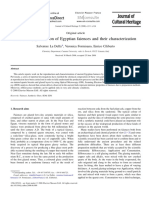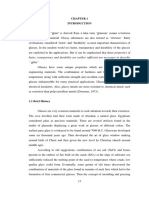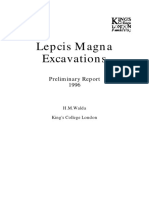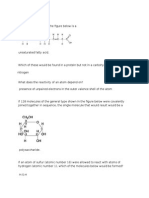Analysis of Raw Glass From Carthage HIMT
Analysis of Raw Glass From Carthage HIMT
Uploaded by
r monpeanCopyright:
Available Formats
Analysis of Raw Glass From Carthage HIMT
Analysis of Raw Glass From Carthage HIMT
Uploaded by
r monpeanCopyright
Available Formats
Share this document
Did you find this document useful?
Is this content inappropriate?
Copyright:
Available Formats
Analysis of Raw Glass From Carthage HIMT
Analysis of Raw Glass From Carthage HIMT
Uploaded by
r monpeanCopyright:
Available Formats
INSTITUT NATIONAL D',ARCHEOLOGIE ET 0' ART DE TUNISIE
AND BRITISH ACADEMY TUNISIA COMMITTEE
EXCAVATIONS AT CARTHAGE
THE BRITISH MISSION
VOLUME II, 1
THE CIRCULAR HARBOUR, NORTH SIDE
THE SITE AND FINDS OTHER THAN POTTERY
BY
H.R.HURST
Contributions by
C. Duhig, S.P. Ellis, S. Gibson. M. Henig, I.C. Freestone,
G. Lloyd-Morgan, M.A. Levine, D.R Pringle, R Reece,
V.A. Tatton-Brown, RF. Tylecotet. W.A. van Zeist,
A. Wheeler, J. Zaouali
.. '.
Published for THE BRITISH ACADEMY
by OXFORD UNIVERSITY PRESS
1994
, 290 CHAPTER 15
c.t. no. and type No. or uamples several components. namely iron. manganese and titanium oxides
5. deep bowl 5 (FeO. MnO and Ti02 respectively). A typical Roman vessel or
17. 19.20.22-3. conical beakers 11 window glass without "deliberate" colouration (i.e. where the blue or
25. concave beaker bases 9 green colour is incidental due to impurities in the raw materials) has
28-31. beaded-stemmed goblets II less than I% each of FeO and MnO and less than 0.3% Ti02; glasses
32-3. plain-stemmed goblets 12 32831 and 32834 would not therefore be unusual for Roman glass
34. slender splayed·stem goblets 5 (Vel de op.cil .• Velde and Gendron op.cit.). However. several of the
36-7. folded-in goblet feet 9 present glasses are exceptionally high in all of these components
(32832.32833 and 33027) with up to 0.7% Ti02' 2.7 MnO and 3.3%
The concave bases (no. 25) and the beaded- and splayed- FeO. Furthermore. there is a very marked correlation between FeO
stemmed goblets (nos. 28-31 and 34) featured in the and Ti02. and a less marked correlation between FeO and MnO.
comparable list at AvB. Discounting the goblet feet, deep The high concentrations of iron and titanium in the glasses result in
their green colouration. Greens and yellow of this type arc not
bowls (no. 5) and conical beakers (nos._17-19) emerge as
generally considered to be deliberate but the result of unintentional
more common on this site than at AvB. In the case of the incorporation of the colourant elements in the glass. Generally in
bowls, this is probably a reflection of their date. since two Roman glass iron oxide was at the level of one percent or less. and the
of the five were from Istl2nd-century contexts, suggesting colouring effects of iron were counteracted by the addition of
that this was an early type. The earliest context for a conical manganese oxide (Sayre 1963).
The explanation for the unusually high concentrations in the
beaker was phase 4.7d. generally associated with pottery of
Carthage fragments probably lies in the contamination of the glasses
1stl2nd century date, but all the other contexts were 4th- with iron and titanium by poorly selected raw material (sand) or by
century or later. ThIJS chronology does not seem to be the dissolution of the 'melting pot. This would have produced a strongly
reason these vessels were more common on the present site. coloured glass and an attempt has been made to reduce the colouration
On the other side, one or two very common forms at AvB. by the addition of excess manganese oxide (MnO). Unfortunately at
the exceptionally high concentrations of iron and titanium in these
were lacking on the present site, notably nos. 97, the concave glasses. the manganese oxide has proven ineffective as a decolourant
base now reclassified as belonging to a beaker (of which there so that the high iron-manganese-titanium ("HIMT") glasses (32832.
were some 44 examples or 8% of the entire glass assemblage), 32833. 33027) are stongly coloured relative to. for example. 32831
and nos. 98-9, cylindrical flasks or jugs with pushed-in tubular (yellow-green) and 32834 (pale blue).
base rings (27 examples or 5% of the assemblage). In other Other examples of HIMT glass of Roman date appear rare. but one of
forty-eight peices of Gallo-Roman glass analysed by Velde (l9S5) has a
respects the two collections were similar. similar composition with 0.6% Ti02' 2.2% MnO and 2.0% FeO. Given
that the present analystica1 sample was deliberately selected to include
lighter pieces to give a full range of colour. HIMT glass is likely to be
APPENDIX: CHEMICAL ANALYSIS OF even more strongly represented in the Carthage group than is indicated . .
by Table I.emphasising the unusual nature of the material.
'RAW' GLASS FRAGMENTS The fragments of glass from Carthage are likely to have been raw glass
broken up for use in glass-working. Their strong colour caused them to be
by I.C. Freestone
rejected by the craftsman and discarded. The presence of some less
strongly coloured material in this sample is not surprising. as a certain
Around twenty angular glass fragments. up to about 4 em across and amount of accidental loss and wastage in such a process in inevitable.
weighing approximately 500g in total. were submitted for examination. The presence of a group of glass fragments with a high proportion
The fragments are all transparent, and range from pale yellow to dark of deliberately discarded material strongly suggests that sorting of raw
olive green in colour. although one fragment is a distinctive pale blue. glass fragments was occurring in the vicinity. and that glass-working
As indicated elsewhere. they appear to be the result of breaking up large was occurring nearby.
pieces of raw glass; vessel fragments. drips and trails are absent.
TABLE I - Energy Dispersive X-ray Analysis of Glass Culler
ANALYSIS Sample No. 32831 32832 32833 32834 33027 33028
Location Rm7 RmB7 RmB2 Rm IS RmB9 Rm7(S
Small samples were broken from six of the samples selected to robber tr.)
represent the range of colours present. including the pale blue. They Layer 657 604 150 179 603 46
were mounted in epoxy resin. polished. coated with a thin layer of Phase 4.3Sd 4.36f 10 5.27b 4.3Sc 10
carbon and analysed by energy dispersive x-ray analysis in the scanning
electron microscope; for details see Bimson and Freestone (1988). Si02 68.5 64.2 63.7 69.4 64.8 65.9
TI02 0.2 0.7 0.5 0.2 0.7 0.2
AI203 I.S 3.3 2.8 2.9 3.2 2.7
FcO 1.0 3.3 2.0 0.5 2.1 1.0
RESULTS AND DISCUSSION MnO 0.8 1.6 2.7 0.2 2.7 1.9
MgO 0.5 1.2 I.l 1.0 1.3 1.3
The analyses are presented in Table I. The glasses are of the soda- CaO 6.4 5.0 6.5 9.5 5.2 8.6
lime-silica type. typical in this respect to most other Mediterranean Na20 19.4 18.4 18.4 15.5 IS.7 16.9
glass. Their low magnesia (MgO in the range of 0.5-1.3%) and potash K20 0.3 0.4 0.5 0.3 0.4 0.8
(K20) in the range 0.3-0.8%) are typical of glass of the Roman CI 1.0 1.0 0.9 0.9 1.1 0.9
period. as opposed to Islamic glass in which concentrations of these 0.3 0.1 0.3 0.1 0.1 0.2
5°2
oxides are higher (Sayre and Smith 1'961). Alumina (AI203) at
1.&-3.3% is also typical of Roman glass (eg. Bimson and Freestone NOles Results in weight per cent. Analyses carried out by energy
1983. Velde 1985. V!:lde and Gendron 1980). dispersive x-ray analysis in a JEOl JSM840 scanning electron
In detail. however. this group of glasses shows some unusual microscope. Other elements analysed but not detected include
features. In particular a number of the samples are unusually high in antimony, lead. tin and copper.
You might also like
- Rutile Oct17Document2 pagesRutile Oct17api-308735650100% (3)
- HALL, Jonathan M. - Ethnic Identity in Greek Antiquity 1997 PDFDocument242 pagesHALL, Jonathan M. - Ethnic Identity in Greek Antiquity 1997 PDFr monpean100% (2)
- Process Paper NHDDocument2 pagesProcess Paper NHDapi-591982088No ratings yet
- Catalogue,: ON Meteoric Iron From Four Corners, San Juan County, New GzorgsDocument7 pagesCatalogue,: ON Meteoric Iron From Four Corners, San Juan County, New Gzorgsbuhl66No ratings yet
- CAMPBELL (1933) Greek and Roman Plated CoinsDocument75 pagesCAMPBELL (1933) Greek and Roman Plated Coinspax_romana870No ratings yet
- GitaDocument5 pagesGitaPhani LankaNo ratings yet
- ITRI Pub 602Document14 pagesITRI Pub 602martinpsNo ratings yet
- Micro Analysis Crystals 1Document15 pagesMicro Analysis Crystals 1nikrouNo ratings yet
- Tektite or Obsidian-Cali GlassDocument2 pagesTektite or Obsidian-Cali GlassLaura Daniela Jimenez PradaNo ratings yet
- The Roman Ceramic Building Material From Partney: Alan Vince and Kate SteaneDocument7 pagesThe Roman Ceramic Building Material From Partney: Alan Vince and Kate SteaneFrida HorvathNo ratings yet
- The British Museum - Technical Research Bulletin, 2008 Vol2, Philip J Fletcher PDFDocument5 pagesThe British Museum - Technical Research Bulletin, 2008 Vol2, Philip J Fletcher PDFFloki BadAnNo ratings yet
- CM28 229Document11 pagesCM28 229Sahroz KhanNo ratings yet
- Raw Materials For Making Jingdezhen Porcelain From The Five Dynasties To The Qing DynastyDocument7 pagesRaw Materials For Making Jingdezhen Porcelain From The Five Dynasties To The Qing DynastyFURY FURIONNo ratings yet
- Atmospheric Corrosion of Copper and The Colour Structure and Composition of Natural Patinas On Copper 2006 Corrosion ScienceDocument30 pagesAtmospheric Corrosion of Copper and The Colour Structure and Composition of Natural Patinas On Copper 2006 Corrosion ScienceEmanuela Leite FragosoNo ratings yet
- Gollop - 1992 - Microstructural and Microanalytical Studies of Sulfate Attack. I - Ordinary Portland Cement PasteDocument12 pagesGollop - 1992 - Microstructural and Microanalytical Studies of Sulfate Attack. I - Ordinary Portland Cement PasteLautaro SantillanNo ratings yet
- Henderson, Julian - Glass Production and Bronze Age EuropeDocument17 pagesHenderson, Julian - Glass Production and Bronze Age EuropeHelena HrdličkováNo ratings yet
- The Role of Sulphur in The Early Production of Copper - 2023 - Ceramics InternaDocument12 pagesThe Role of Sulphur in The Early Production of Copper - 2023 - Ceramics Internasimransharma0524No ratings yet
- Merril G.P. - On A Stony Meteorite From Anthony, Harper County, Kansas, and A Recently Found Meteoric Iron From Mejillones, Chile (1924)Document7 pagesMerril G.P. - On A Stony Meteorite From Anthony, Harper County, Kansas, and A Recently Found Meteoric Iron From Mejillones, Chile (1924)Javier Calfunao VarasNo ratings yet
- 26Document4 pages26gohari75No ratings yet
- 1 s2.0 0304386X85900210 MainDocument17 pages1 s2.0 0304386X85900210 MainJuan Guzmán SantosNo ratings yet
- General Mineralogy: Mineralogy and Petrology of Some SamplesDocument4 pagesGeneral Mineralogy: Mineralogy and Petrology of Some Sampleszoomr85No ratings yet
- F3 GR.5 3G Metallurgy, Soil, Dust&DirtDocument5 pagesF3 GR.5 3G Metallurgy, Soil, Dust&DirtJojoNo ratings yet
- 08 - Chapter 1Document24 pages08 - Chapter 1Pothuraju PrudhiviNo ratings yet
- The Prehistoric Heat Treatment of Flint in CornwallDocument11 pagesThe Prehistoric Heat Treatment of Flint in CornwallAmanda HillNo ratings yet
- Excavations at Stansted Airport: Fired ClayDocument12 pagesExcavations at Stansted Airport: Fired ClayFramework ArchaeologyNo ratings yet
- Mass-Produced Mullite Crucibles in MedieDocument4 pagesMass-Produced Mullite Crucibles in MedieadamdwaldropNo ratings yet
- Ammoniacal Nitrogen Removal From Water BDocument7 pagesAmmoniacal Nitrogen Removal From Water BOth ShuNo ratings yet
- Archaeology and Archaeometry of A Local Production of Black Glazed Ware at PompeiiDocument6 pagesArchaeology and Archaeometry of A Local Production of Black Glazed Ware at PompeiiErika CappellettoNo ratings yet
- Recovering The Tinsmith's ArtDocument7 pagesRecovering The Tinsmith's ArtPaul Lau100% (1)
- An Investigation of A Suite of Black Diamond JewelryDocument6 pagesAn Investigation of A Suite of Black Diamond JewelrySamseven JoenineNo ratings yet
- Lucerna 13 January 1997Document11 pagesLucerna 13 January 1997kevinzhao704No ratings yet
- Deterioration of CopperDocument58 pagesDeterioration of CopperNadina BostanNo ratings yet
- The Lycurgus Cup - A Roman NanotechnologyDocument8 pagesThe Lycurgus Cup - A Roman NanotechnologyThia1984No ratings yet
- Analyzing The Vinland Map - Full-Text Article - Clark, 2002Document1 pageAnalyzing The Vinland Map - Full-Text Article - Clark, 20028c3rajivasukeertimloNo ratings yet
- Minerals at Mottled ZoneDocument7 pagesMinerals at Mottled Zonekanwaljeetsingh05No ratings yet
- Augen Gneiss From GreenlandDocument3 pagesAugen Gneiss From GreenlandTanmay KeluskarNo ratings yet
- Experimental Study of Historical Processing of Cobalt Arsenide Ore For Colouring Glazes (15-16th Century Europe)Document10 pagesExperimental Study of Historical Processing of Cobalt Arsenide Ore For Colouring Glazes (15-16th Century Europe)jmoleraNo ratings yet
- Tracing Sedimentary TexturesDocument2 pagesTracing Sedimentary Texturesbinod2500No ratings yet
- Between Egypt Mesopotamia and Scandinavi PDFDocument14 pagesBetween Egypt Mesopotamia and Scandinavi PDFLars BendixenNo ratings yet
- Making Money in Classical AthensDocument13 pagesMaking Money in Classical AthenswevanoNo ratings yet
- Mcmillan, 1979 Fig. 3Document3 pagesMcmillan, 1979 Fig. 3Iullia CarmainNo ratings yet
- Reactivity of Clay Minerals With Acids and Alkalis PDFDocument13 pagesReactivity of Clay Minerals With Acids and Alkalis PDFPuturrú De FuáNo ratings yet
- Faience: An Investigation of The Microstructures Associated With The Different Methods of GlazingDocument12 pagesFaience: An Investigation of The Microstructures Associated With The Different Methods of GlazingAlyaa GamalNo ratings yet
- Exley1956 MethodOfImpregnatingFriableRocksForTheCuttingOfThinSections MM31 235 347Document3 pagesExley1956 MethodOfImpregnatingFriableRocksForTheCuttingOfThinSections MM31 235 347karma2011No ratings yet
- Zeolitic Alteration of Pyroclastics M. N. Bnaurbrrn' Anr E. Posnler AnsrnncrDocument5 pagesZeolitic Alteration of Pyroclastics M. N. Bnaurbrrn' Anr E. Posnler AnsrnncrSArumpaetNo ratings yet
- Study of Pinholes Genesis in Iron Castings: Archives of Foundry EngineeringDocument6 pagesStudy of Pinholes Genesis in Iron Castings: Archives of Foundry EngineeringFabiano MonteiroNo ratings yet
- Lead Glass Treated Blue Sapphire by Hainschwang 2008Document2 pagesLead Glass Treated Blue Sapphire by Hainschwang 2008Vaishali JhaveriNo ratings yet
- Möncke JAS2014 RomanDocument14 pagesMöncke JAS2014 RomanechoffmannNo ratings yet
- Jadarite, Linasib O (Oh), A New Mineral Species From The Jadar Basin, SerbiaDocument6 pagesJadarite, Linasib O (Oh), A New Mineral Species From The Jadar Basin, SerbiaShokokuro RuiazuNo ratings yet
- Chapter 9 METALLURGY PETROGRAPHYDocument6 pagesChapter 9 METALLURGY PETROGRAPHYRosalen Damacino Sangco100% (1)
- Chemistry of Deteriorated Smalt Pigment Marika SpringDocument4 pagesChemistry of Deteriorated Smalt Pigment Marika SpringAnaLizethMataDelgadoNo ratings yet
- Patten Et Al., 2017Document22 pagesPatten Et Al., 2017rom LeeNo ratings yet
- Effects of Dry Grinding and Leaching On The Crystal Structure of ChrysotileDocument7 pagesEffects of Dry Grinding and Leaching On The Crystal Structure of ChrysotileItzel Cruz RamosNo ratings yet
- ROMAN CRAFTS 03 Donald Strong & David BrownDocument11 pagesROMAN CRAFTS 03 Donald Strong & David BrownPetraNo ratings yet
- Examining and Conserving An Egyptian Anthropoid Coffin From 380Document19 pagesExamining and Conserving An Egyptian Anthropoid Coffin From 380Basem GehadNo ratings yet
- Chapter 2Document9 pagesChapter 2mahmoudahmed30902No ratings yet
- Analysis of Roman Enamelled BroochesDocument16 pagesAnalysis of Roman Enamelled BroochesDanielnjbNo ratings yet
- REV088C06Document86 pagesREV088C06manas773No ratings yet
- Ultramarine Blue From Asturian "Hard" KaolinsDocument10 pagesUltramarine Blue From Asturian "Hard" KaolinsElena ShabunyaNo ratings yet
- M6 - Artifact Concretions and Other ArtifiactsDocument28 pagesM6 - Artifact Concretions and Other ArtifiactsAnaRitaTrindadeNo ratings yet
- The Journal of GemmologyDocument64 pagesThe Journal of GemmologyanpanmanpiedNo ratings yet
- Analyses of Colourless Roman GlassDocument21 pagesAnalyses of Colourless Roman GlassDanielnjbNo ratings yet
- Lead Smelting and Refining, With Some Notes on Lead MiningFrom EverandLead Smelting and Refining, With Some Notes on Lead MiningNo ratings yet
- The Poetics of History From Below Perspectives On History AHADocument7 pagesThe Poetics of History From Below Perspectives On History AHAr monpean100% (1)
- (The Cultural Histories Series - A Cultural History of The Senses Volume 1) Jerry Toner - A Cultural History of The Senses in Antiquity (2019)Document281 pages(The Cultural Histories Series - A Cultural History of The Senses Volume 1) Jerry Toner - A Cultural History of The Senses in Antiquity (2019)Gsar Gsar GsarNo ratings yet
- GOODCHILD, R.G. - Roman Sites On The Tarhuna Plateau of TripolitaniaDocument42 pagesGOODCHILD, R.G. - Roman Sites On The Tarhuna Plateau of Tripolitaniar monpeanNo ratings yet
- Matthews-1970-Olympiodorus of Thebes and TheDocument19 pagesMatthews-1970-Olympiodorus of Thebes and Ther monpeanNo ratings yet
- Lepcis Magna - Preliminary Report 1996Document9 pagesLepcis Magna - Preliminary Report 1996r monpeanNo ratings yet
- Lewis-1970-Roman Gold-Mining in North-West SpainDocument25 pagesLewis-1970-Roman Gold-Mining in North-West Spainr monpeanNo ratings yet
- HARDEN, D. B. - Punic Urns From The Precinct of Tanit at Carthage PDFDocument15 pagesHARDEN, D. B. - Punic Urns From The Precinct of Tanit at Carthage PDFr monpeanNo ratings yet
- Erim-1970-The Copy of Diocletian's EdictDocument26 pagesErim-1970-The Copy of Diocletian's Edictr monpeanNo ratings yet
- Jones 1970 Sura and SenecioDocument7 pagesJones 1970 Sura and Senecior monpeanNo ratings yet
- HUNT, Patrick - The Locus of Carthage - Compounding Geographical LogicDocument18 pagesHUNT, Patrick - The Locus of Carthage - Compounding Geographical Logicr monpeanNo ratings yet
- MGT320 Ch01Document24 pagesMGT320 Ch01Payman RowhaniNo ratings yet
- Chapter 7.1Document25 pagesChapter 7.1Hosam AliNo ratings yet
- Adden-B-Installing - OMV5 - On - An R-PI PDFDocument21 pagesAdden-B-Installing - OMV5 - On - An R-PI PDFmaguado1992No ratings yet
- ANANDAN.R, M.A M. Phil Research Scholar (Geography) Dept. of Geography Govt. Arts College, CoimbatoreDocument13 pagesANANDAN.R, M.A M. Phil Research Scholar (Geography) Dept. of Geography Govt. Arts College, CoimbatoreAnandan RNo ratings yet
- What Is Business Administration All AboutDocument8 pagesWhat Is Business Administration All AboutMukhtar MaxamedNo ratings yet
- The Effect of The Licker-In Speed On Fibre Properties On Modern Carding Machines With A Triple Licker-InDocument14 pagesThe Effect of The Licker-In Speed On Fibre Properties On Modern Carding Machines With A Triple Licker-Inhalil ibrahim akanNo ratings yet
- Ca - Pefy P80 - 250VMH e FDocument1 pageCa - Pefy P80 - 250VMH e FAnnie CortezNo ratings yet
- Cot 1 2023Document4 pagesCot 1 2023Honey Brylle TandayagNo ratings yet
- Checklist of DocumentsDocument8 pagesChecklist of DocumentstanishaNo ratings yet
- Personal Financial Planning LectureDocument52 pagesPersonal Financial Planning LectureSara LlameraNo ratings yet
- Nitrogen CycleDocument18 pagesNitrogen Cycle'Rex Lee Saleng DullitNo ratings yet
- Engineering Economics: Finding P, F and ADocument14 pagesEngineering Economics: Finding P, F and Abyun baekNo ratings yet
- Use of English File: Unit 5: On A Business TripDocument20 pagesUse of English File: Unit 5: On A Business TripOsmarNo ratings yet
- Interim Financial ReportingDocument3 pagesInterim Financial ReportingBernie Mojico CaronanNo ratings yet
- Honors Biology Midterm Study GuideDocument17 pagesHonors Biology Midterm Study GuideEmilyNo ratings yet
- Financial Management Capital BudgetingDocument16 pagesFinancial Management Capital Budgetingsantillan.arnaldo.duranNo ratings yet
- Lecture-4 - Introduction To Contrcts and ObligationsDocument27 pagesLecture-4 - Introduction To Contrcts and ObligationsJoseph Berlin JuanzonNo ratings yet
- Colt 1911a1 1939 U.S. Navy Contract..Document25 pagesColt 1911a1 1939 U.S. Navy Contract..anon_835518017No ratings yet
- Standard 13 End Show: Presentation Created by Simon Perez. All Rights Reserve DDocument28 pagesStandard 13 End Show: Presentation Created by Simon Perez. All Rights Reserve DJay Ventura AsuncionNo ratings yet
- Genius 3151 3160Document21 pagesGenius 3151 3160Ejay RamonalNo ratings yet
- Huawei ICT Competition 2020 Hands-On Lab ExamDocument18 pagesHuawei ICT Competition 2020 Hands-On Lab Exammichelle chemutaiNo ratings yet
- Information Theroy and Coding Soumya Panja 34230820017Document7 pagesInformation Theroy and Coding Soumya Panja 34230820017panjasoumya22No ratings yet
- Astro Support ResistanceDocument24 pagesAstro Support ResistanceVinod PatilNo ratings yet
- Cancer Patient RequestDocument3 pagesCancer Patient RequestEbiemNo ratings yet
- Idec Designingclil TPDocument3 pagesIdec Designingclil TPha nguyenNo ratings yet
- Reflection Paper (Philippine-American Cultural Interaction)Document2 pagesReflection Paper (Philippine-American Cultural Interaction)MASSO CALINTAANNo ratings yet
- How Individuals Can Drive Climate Action: Australian Centre For Education TrainingDocument12 pagesHow Individuals Can Drive Climate Action: Australian Centre For Education Trainingapi-524326187No ratings yet
- Easy Reading - Milly's Busy DayDocument2 pagesEasy Reading - Milly's Busy DaybeckyNo ratings yet




































































































